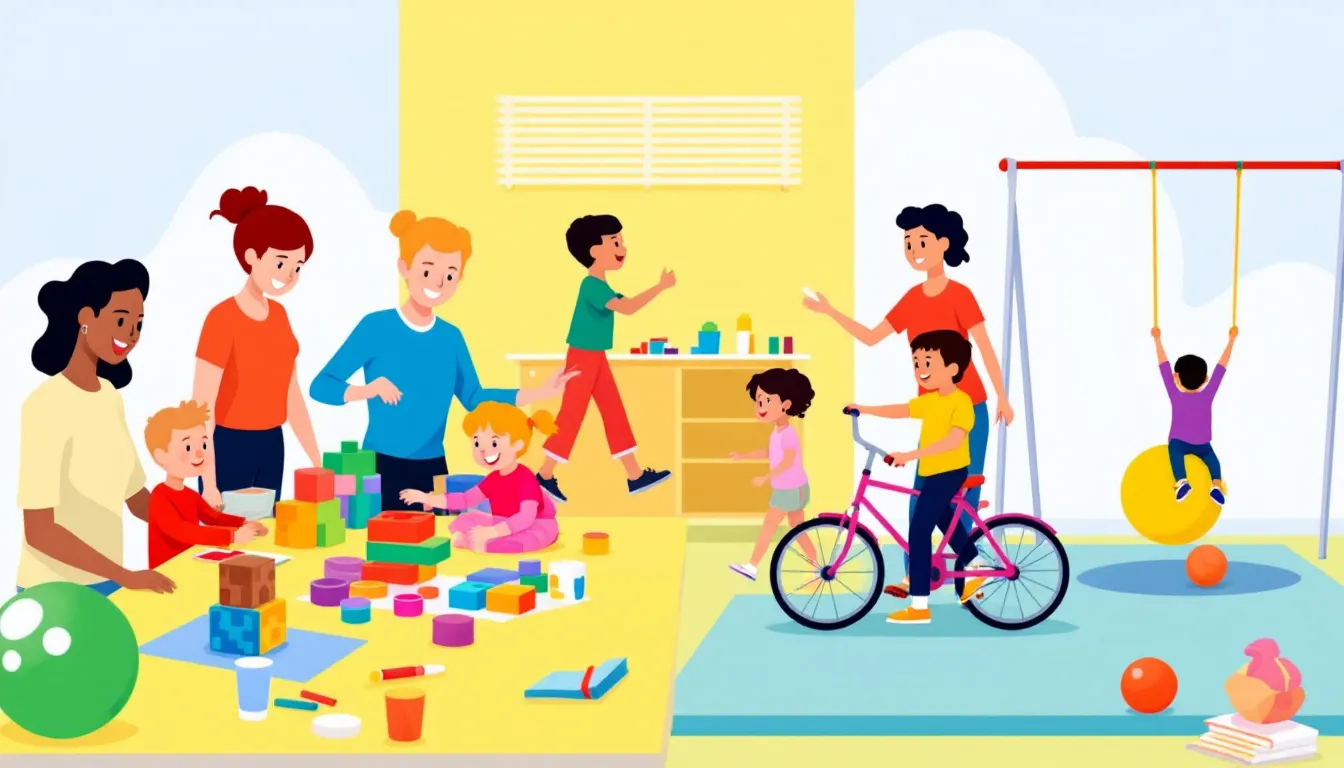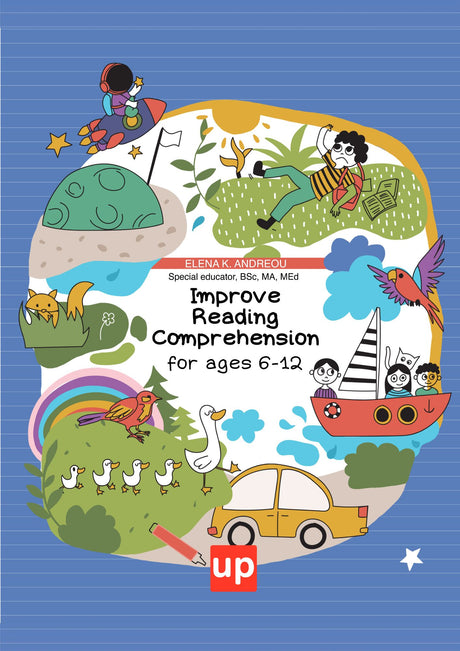Struggling with motor coordination in children with autism? Discover motor planning activities for autism that can enhance both fine and gross motor skills. This article guides you through effective activities and daily routines that make a noticeable difference in your child’s development.
Key Takeaways
- Motor planning challenges in autistic children can impact their gross and fine motor skills, affecting daily activities and overall independence.
- Engaging in targeted activities such as obstacle courses, animal walks, and sensory integration strategies can significantly enhance motor planning skills.
- Professional support from occupational and physical therapists, combined with parental collaboration, is essential for developing effective motor planning strategies in children with autism.
Understanding Motor Planning in Autism

Motor planning is an intricate process that involves the brain wiring steps for both gross and fine motor skills. Children with autism often face significant challenges in this area, impacting their ability to navigate and interact with their environment effectively.
Gross motor skills are vital for everyday navigation, play, and routines, contributing to a child’s independence and confidence, as well as supporting gross motor development.
What is Motor Planning?
Motor planning refers to the brain’s impressive skill in conceiving and organizing actions, including the motor plan for executing a sequence of those actions effectively. This complex process helps individuals know and remember the steps required for distinct movements or tasks. It includes both gross motor skills, which involve large muscle movements, and fine motor skills, which involve smaller, more precise movements.
Coordination is essential in this process, ensuring that physical activities are organized for efficient movement.
Why Motor Planning is Challenging for Autistic Children
Motor planning can be a considerable challenge for autistic children due to differences in brain wiring affecting sensorimotor integration.
These differences can hinder their ability to effectively process sensory data and environmental information, leading to difficulties in coordination and motor planning.
For instance, children may struggle with tasks that require coordination, such as:
- balancing
- running
- jumping
- throwing a ball
- riding a bike
Furthermore, sensory processing challenges are common among autistic children and can interfere with motor planning abilities. Anxiety and reduced core stability can also play significant roles, as they impact posture, balance, and overall stamina, all crucial for effective motor planning.
These factors combined often result in avoidance behaviors, limiting opportunities for practice and skill development.
Signs of Motor Planning Difficulties

Early intervention requires recognizing signs of motor planning difficulties. Children with autism may exhibit clumsiness and often avoid engaging in physical activities due to these challenges. They may also struggle with tasks that require coordination and physical engagement, such as climbing or balancing. These difficulties can manifest in various ways, from avoiding physical tasks to exhibiting inconsistent performance in motor tasks.
Many autistic children face challenges in learning new physical skills, which can manifest as a lack of coordination and an inability to engage effectively in physical activities. Identifying these signs early can help in seeking appropriate interventions to support their development.
Recognizing Motor Planning Challenges
Motor planning is the brain’s capacity to visualize, organize, and execute movement sequences. Many autistic children experience both gross and fine motor delays, affecting their daily functioning. These challenges, often termed as praxis difficulties, make it hard for them to participate in physical activities and learn new skills.
Recognizing these challenges early can help in implementing strategies to enhance their motor planning skills.
Impact on Daily Activities
Motor planning difficulties can significantly impact a child’s daily activities. Tasks requiring balance and coordination, such as dressing or using utensils, can become daunting. Differences in brain structure and sensory integration challenges further complicate these tasks. Children with autism may also experience low muscle tone or joint hypermobility, affecting their core stability and overall motor function.
Integrating motor planning activities into daily routines can help reinforce skills through consistent practice. This consistent engagement not only enhances physical coordination but also boosts cognitive skills, leading to a more holistic development.
Effective Motor Planning Activities

Engaging in specific activities can significantly enhance motor planning skills in children with autism. Activities like obstacle courses, animal walks, and sensory integration strategies are particularly effective in developing both gross and fine motor skills. These activities support the development of motor coordination and planning, making physical tasks more manageable and enjoyable.
Obstacle Courses
Obstacle courses are a fantastic way to improve motor skills and coordination. They can be tailored to include activities that enhance balance and motor coordination through fun physical challenges.
Incorporating crawling, balancing, and climbing in obstacle courses can support the development of bilateral coordination and proprioceptive awareness, making them an excellent tool for motor planning development.
Animal Walks
Animal walks, such as crab and bear crawls, are beneficial for developing motor control and enhancing spatial awareness in children with autism. These activities mimic animal movements and require children to use different muscle groups, improving their overall motor coordination and planning skills.
Sensory Integration Strategies
Sensory integration strategies involve the use of sensory-friendly tools to aid in motor planning development. These tools make activities more engaging and relatable, helping children with sensory processing issues to better integrate sensory information. Incorporating sensory-based tools into activities can enhance motor planning by making tasks more enjoyable and effective.
Regular short interventions are essential for developing motor skills in children with autism. These strategies often include activities that address various sensory systems, fostering overall development and improving motor skill outcomes. Incorporating sensory integration into routine activities allows children to consistently practice and enhance their motor planning skills.
Incorporating Motor Planning into Daily Routines

Incorporating motor planning into daily routines is crucial for consistent practice and skill development. Simple home exercises and everyday activities can significantly enhance a child’s motor planning abilities.
Integrating these activities into daily routines helps reinforce motor planning skills, making physical tasks more manageable and enjoyable for children with autism.
Morning Routine Activities
Morning routines offer excellent opportunities for practicing motor planning skills. Activities like dressing and brushing teeth require coordination and planning, making them ideal for motor skill practice. Parents can enhance their child’s motor planning by integrating structured play and movement activities into their morning routines.
Incorporating motor planning activities into morning routines can lead to improved skills and greater confidence in children. These activities not only help in developing motor skills but also make daily routines more engaging and productive.
Playtime Opportunities
Playtime is a crucial period for developing motor planning skills. Activities like trampoline jumping, ball games, and pretend play motivate children and create enjoyable learning experiences. These activities help in improving gross motor skills and social skills, making playtime a vital part of a child’s development.
Active parent involvement is essential for reinforcing learned motor skills and ensuring consistent practice at home. Tasks requiring the use of both hands together foster better bilateral coordination, essential for daily activities.
Mealtime Skills
Mealtime activities can be used to develop fine motor skills. Using various pasta shapes during meals can aid in developing fine motor skills through sorting and manipulation. These activities provide excellent opportunities for fine motor skill development, making mealtime both engaging and productive.
Task-based activities, such as play dough manipulation or using tweezers to pick up small objects, can significantly improve fine motor control and dexterity. Incorporating these activities into mealtime routines can enhance a child’s motor planning abilities and overall skill development.
Professional Support for Motor Planning Development

Professional support is crucial for children with motor planning difficulties. Interventions from occupational therapists and physical therapists can significantly enhance motor planning skills. These professionals use tailored strategies to help children achieve significant milestones, such as improved running, jumping, and riding a tricycle.
Occupational Therapy
Occupational therapists work closely with autistic children to tailor interventions that improve motor planning skills. These sessions often involve targeted interventions and parental involvement to enhance motor planning and overall development. Children on the autism spectrum may take longer to learn new motor skills due to differences in brain connectivity, making occupational therapy essential for their development.
Active engagement by parents in therapy sessions leads to better understanding and support for their child’s developmental needs. Through occupational therapy, children can develop the motor planning skills needed for daily activities and independence.
Physical Therapy
Physical therapy enhances motor skills essential for daily activities, supporting motor planning development in children with autism. Occupational therapists work closely with autistic children to enhance motor planning through targeted interventions that improve motor control and body awareness.
These therapies are crucial for maximizing progress and helping children achieve their full potential in motor skills.
Parent Collaboration
Parent collaboration is vital for reinforcing motor planning activities at home. Consistent practice opportunities are essential for effective skill enhancement in motor planning. Working closely with therapists and following practical tips allows parents to significantly support their child’s development.
This collaboration ensures that motor planning activities are consistently practiced, leading to better outcomes for the child.
Simple Home Exercises for Motor Planning
Simple home exercises are crucial for developing motor planning skills in children with autism. Activities like crawling, jumping, and balance tasks provide proprioceptive feedback essential for body awareness and coordination. Integrating these exercises into daily routines creates opportunities for consistent practice and skill development.
Hand-Eye Coordination Exercises
Hand-eye coordination exercises, such as tossing balls into targets or throwing and catching a ball, can effectively improve visual tracking and hand-eye synchronization. These activities help enhance coordination between visual input and hand movements, making everyday tasks more manageable for children.
Bilateral Coordination Activities
Bilateral coordination activities, such as clapping games, promote the use of both sides of the body, enhancing coordination skills. Games that require using both sides of the body, like clapping while singing, can foster better bilateral coordination.
Such activities are essential for developing the coordination skills necessary to use both sides of the body effectively.
Fine Motor Control Tasks
Fine motor skills involve precise movements typically using the hands and fingers for tasks like writing. Activities such as threading beads, using tweezers, or manipulating play dough are effective for improving fine motor control and dexterity. These fine motor tasks help children develop the efficient fine motor skills needed for daily activities like dressing, using cutlery, and writing.
Using specially shaped cutlery can assist children with autism in positioning their fingers correctly for effective use. Handwriting may not represent cognitive ability and is often not enjoyable for students with motor coordination difficulties, making alternative fine motor activities crucial for their development.
Summary
Summarizing the key points, motor planning is essential for the development and independence of children on the autism spectrum. Recognizing motor planning challenges early and incorporating effective activities into daily routines can significantly enhance motor skills. Professional support from occupational and physical therapists, along with active parent collaboration, plays a crucial role in reinforcing these skills.
Incorporating simple home exercises and sensory integration strategies can make a significant difference in a child’s motor planning development. By consistently practicing these activities, children can improve their motor skills, gaining confidence and independence in their daily lives. Together, we can create a supportive environment that encourages growth and development for children with autism.
Frequently Asked Questions
What is motor planning?
Motor planning is the brain's capability to conceive, organize, and execute movements involving both large and small muscles. It plays a crucial role in coordinating physical activities effectively.
Why is motor planning challenging for autistic children?
Motor planning can be particularly challenging for autistic children due to differences in brain wiring that impact sensorimotor integration, leading to difficulties with coordination and sensory processing. These factors, coupled with anxiety, can hinder their ability to develop essential motor skills.
What are some signs of motor planning difficulties?
Signs of motor planning difficulties include clumsiness, avoidance of physical tasks, challenges with coordination, and inconsistency in performing motor tasks. It's important to recognize these signs for timely support.
How can sensory integration strategies help with motor planning?
Sensory integration strategies enhance motor planning by engaging children through sensory-friendly tools and activities, which cater to various sensory systems. This approach improves overall motor skill outcomes effectively.
What role do parents play in motor planning development?
Parents play a vital role in motor planning development by reinforcing activities at home and providing consistent practice opportunities, which significantly enhance skill acquisition. Their collaboration with therapists further optimizes the effectiveness of these interventions.
Original content from the Upbility writing team. Reproduction of this article, in whole or in part, without attribution to the publisher is prohibited.
References
- American Occupational Therapy Association. (2021). Occupational Therapy’s Role with Autism.
- Ayres, A. J. (1972). Sensory Integration and Learning Disorders. Western Psychological Services.
- Case-Smith, J., & O'Brien, J. C. (Eds.). (2015). Occupational therapy for children and adolescents. Elsevier Health Sciences.
- Dunn, W. (2007). Supporting children to participate successfully in everyday life by using sensory processing knowledge. Infants & Young Children, 20(2), 84-101.
- Kranowitz, C. S. (2005). The Out-of-Sync Child: Recognizing and Coping with Sensory Processing Disorder. Penguin.
- National Institute of Neurological Disorders and Stroke. (2020). Autism Spectrum Disorder Fact Sheet.
- Schaaf, R. C., & Mailloux, Z. (2015). Clinician’s guide for implementing Ayres Sensory Integration: Promoting participation for children with autism. American Occupational Therapy Association Press.
- Tomchek, S. D., & Dunn, W. (2007). Sensory processing in children with and without autism: A comparative study using the short sensory profile. American Journal of Occupational Therapy, 61(2), 190-200.
- Yack, E., Aquilla, P., & Sutton, S. (2002). Building Bridges Through Sensory Integration. Future Horizons.









